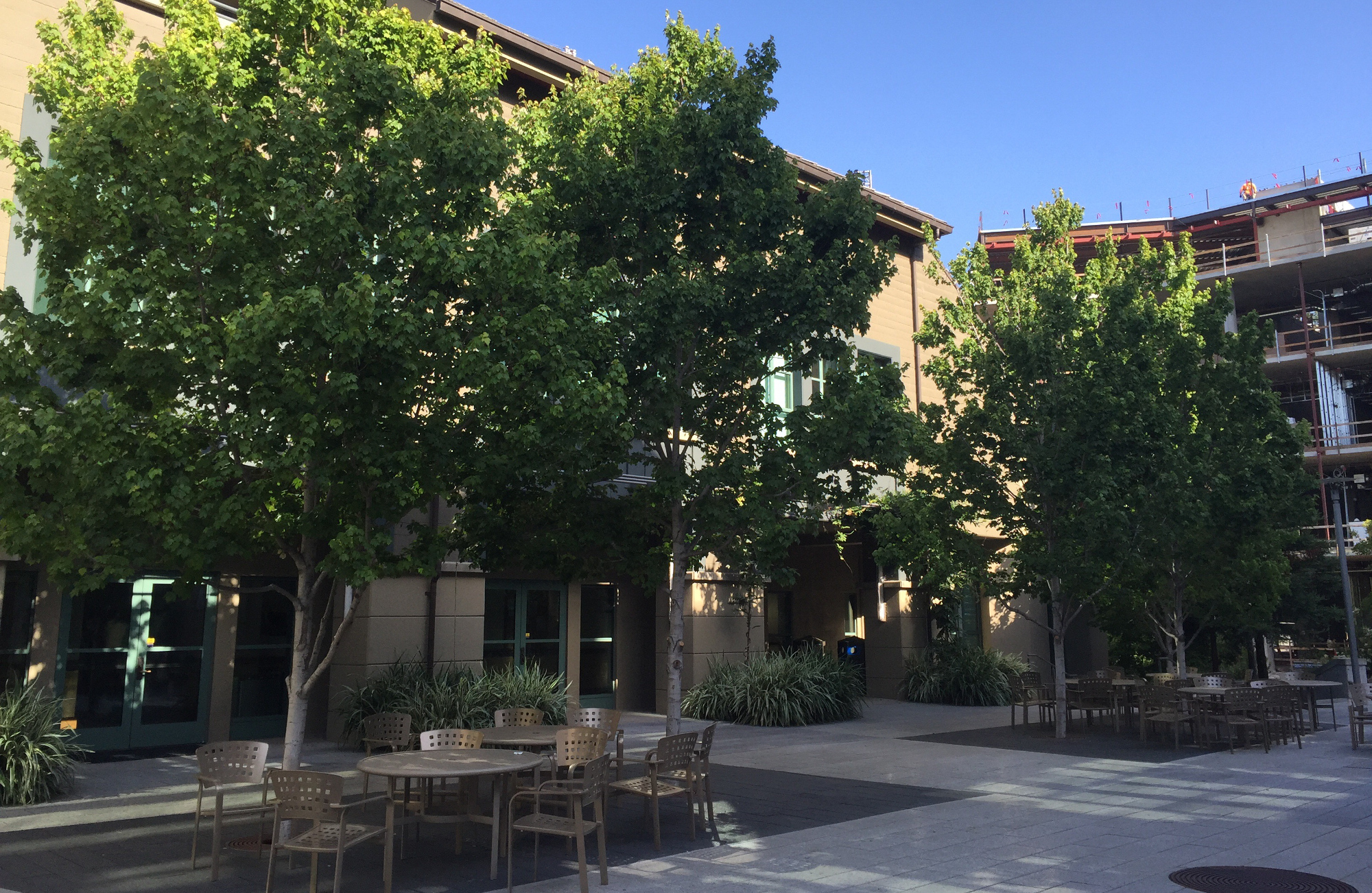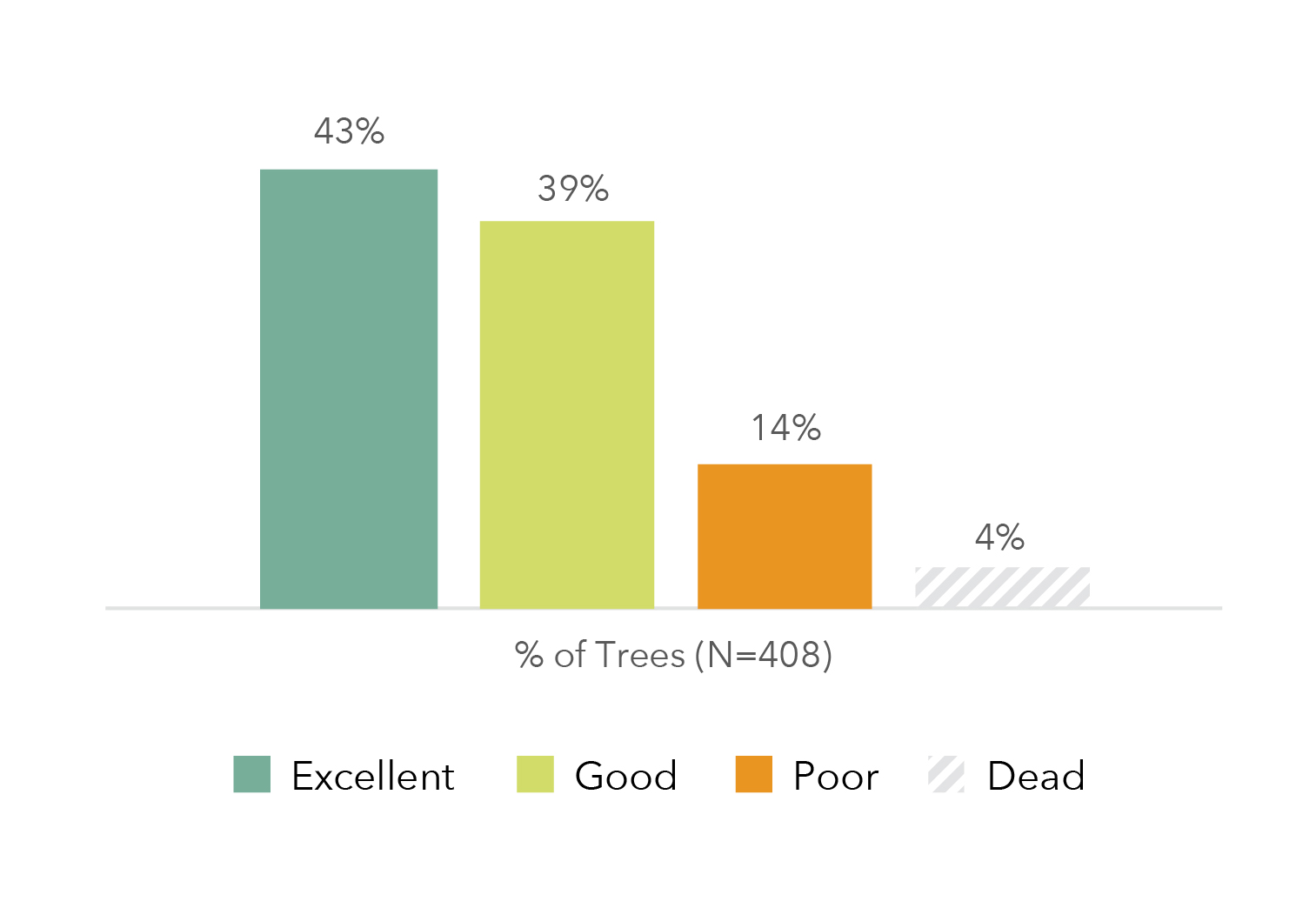This post is the third in a series of three sharing findings from research conducted on 10 Silva Cell projects across North America. Read part one about study design here and part two about our initial findings here.
We’ve already shared some of the initial findings from this study in earlier posts. Today, we’ll discuss those findings and discuss what conclusions we might draw from them.
Overall tree condition
408 trees were given a visual assessment and rated on a scale of 1, 2, 3, or 4 according to guidelines that were shared with each person doing the assessment.
The median tree condition for all project sites was either excellent (N=7) or good (N=3). Projects ranged from an average rating of 1 (“Excellent: Good health, leaves dark green in color and fully covering the canopy”) to 1.9 (“Good: leaves lighting in color, significant leaf edge browning, not fulling covering the canopy or some twig tip dieback. Damage to trunk or branches from impact”). The average health condition across all 10 projects was 1.4, indicating that the trees are in a healthy condition. Note that trees that were removed or dead are included here, but not in the rest of the study analysis, as their growth rate per year could not be measured.
Tree condition scoring is significantly associated with average trunk growth per year, when controlling for type of tree species. On average the trees that were rated “good” grew 0.1 inches less than the trees in the “excellent” group (P=0.003), and trees in the “poor” group grew 0.2 inches less than those in the “excellent” (P<0.001). There is a statistically significant correlation between trunk growth per year and tree condition ratings (R=0.35; P<0.001).
General discussion
Studies of trees in the public landscape have the issue of significant background influences and unknown problems that can impair tree growth and health. For example, contractors rarely follow all the project specifications and details to the letter, and conditions discovered during installation may cause some trees in any project to have slightly or even significantly different soil, watering, and/or drainage conditions. Issues with nursery stock quality are often not known or resolved. Irrigation may not function as planned. Some trees in the planting may suffer from damage caused by humans, dog urine, mechanical damage, or deicing salts. It is often difficult to determine if these influences occurred, and even harder to determine their impact on the outcome. However, nearly all public tree plantings suffer from the same types of problems, therefore understanding how trees planted in Silva Cells may perform against other options in these conditions is an important undertaking.
The results of this study support the thesis that larger volumes of healthy soil make trees better able to thrive in these difficult locations. The study also shows that the use of Silva Cells alone will not assure healthy trees and that the project design must solve the entire set of problems that beset urban trees to give them the best chance of thriving into maturity.
Trunk diameter increase per year was used as the primary measuring point in the study. This is considered a reasonable indicator of tree health over time and reflects when a tree has recovered from transplant shock, or has experienced a severe stress. Trunk diameter is the easiest and most accurate metric to determine and is easily replicated over many sites by different recorders and over time as the study moves forward. Its importance is then balanced by looking at the other metrics and factors that influence tree growth.
The study set a bar of 0.5 inches (1.27 cm) of trunk diameter increase per year as a baseline for comparison. This rate of growth is considered to reflect reasonably good growth in the urban forest for street trees. Trees that grew at or above 0.5” (1.27 cm) per year were considered well-performing, and trees that grew above 0.8 inches (2.03) per year were considered exceptionally healthy. Trees that are growing slower than 0.5” a year are not automatically in poor health. But as growth rates slow they indicate that there are beginning to be some influences that impact the tree growth. These may include factors such as a slower growing species, too little water, too much water, low soil fertility, or low light levels.
Trees that grew between 0.4” and 0.5” (1.01 and 1.27 cm) were considered healthy and to be growing at a reasonable rate depending on species and climate. Trees that grew between 0.3” and 0.4” (0.76 and 1.01 cm) we considered to be growing slowly, but still fast enough to remain viable. Trees that grew between 0.2” and 0.3” (0.50 and 0.76 cm) we considered slow growing, and would benefit from investigation into the cause of the slow growth. Finally, trees that grew at or below 0.2” (0.50 cm) were considered to have very slow growth that may indicate future decline. 68% of the total number of trees in this study had 0.5 inches
(1.27 cm) or more of annual trunk diameter increase, the reference growth rate for normal, healthy street trees. 29% of those were above 0.8 inches (2.03 cm) of trunk diameter increase. 32% of the total number of trees had less than 0.5 inches (1.27 cm) of annual trunk growth. 11%, or about one third of the slower trees, were growing between 0.4 inches (1.01 cm) and 0.5″ (1.27 cm) annually, which is below the reference level used here, but still a healthy growth. 14% had less than 0.29 (0.73 cm) of annual trunk growth. Two replacement trees were included in average growth rate calculations.
It is important to consider if higher tree growth rates are actually desirable. While a faster growing tree usually reflects better growing conditions, faster growth does not translate into longer-lived trees. Wood is not as strong and some disease vectors, particularly some leaf feeding insect activity, may be increased on softer leaf tissue. Pruning cycles are more frequent and the tree may exceed its space faster.
On the other hand, a faster growing tree typically recovers from mechanical damage and has better resources to withstand multiple stress factors. The faster growing tree will gradually slow its growth as it becomes in competition for light and water. Further research on this issue may benefit not only the understanding of tree in soils below pavement, but wider urban forestry concerns.
Only three genera, Quercus, Acer, and Ulmus, have enough replicates to make observations of trends in trunk diameter increase by tree type. Acer has the largest number of data sets (13) and this genus performed well, most above 0.5 inches (1.27 cm) per year and two sets just below 0.5 inches (1.27 cm). While Acer is often used as an urban tree, it also has had performance problems as a street tree. Ulmus, with four data sets, is the best performer – this is not surprising as it is typically a very good urban tree. Quercus has only three data sets, and two are underperforming. Again, this is not too surprising as this genus is often hard to establish.
The remaining sets of trees include eleven different genera, each in only one location, somewhat randomly spread over the breadth of the growth rates. Five of the eleven grew less than 0.4 inches per year. Of that group three tree types, Maackia amurensis, Carpinus caroliniana and Stewartia spp., are very slow growing even in good soil conditions and should be considered as growing reasonable normally. It is likely that tree type is not particularly critical to the success of the system, but also indicates that more research might provide a better understanding of tree selection to the overall success of the approach.
Conclusions
Based on the data from the above projects, it appears that trees growing in Silva Cells perform very well in terms of visual health indicators and annual growth. 82% of trees in the study were given a health rating of either “excellent” or “good.” This is especially notable given the large sample size, the variety of species, climates, and maintenance regimes, and the difficult conditions faced by urban trees.
Silva Cells primarily serve to protect soil from compaction, a major constraint to tree growth as indicated by Coder (2007). This study shows that Silva Cells improve tree performance in urban areas across a wide range of climates, regions, and tree species. The trees that are growing at rates well above (greater than 1”/2.5cm per year) and below (less than 0.3”/0.76cm per year) the normal range of healthy trees require further investigation to see how changes in the design of the system, or maintenance or water regimes, may be impacting the growth positively or negatively. The details of the designs and specifications should be reviewed and compared. The trees growing in excess of 1” (2.5 cm) per year should be followed to see if this rapid growth introduces any management problems.
The study suggests that some additional projects that are designed for stormwater might be added to look more closely at the relationship to soil type and water access, water treatment performance, clogging and maintenance, and other design differences.
This set of well documented trees is an excellent base to examine tree performance in the future as the trees grow. A follow-up study would be appropriate in three to five years. Since this study was undertaken with trees in public environments, there are undoubtedly challenges and abuses to the trees that influence the results and future performance of the trees. The performance metrics found in this study should not be used to predict outcomes of other sets of trees, as it is likely impossible to duplicate the factors that determined growth rates in any individual, group, or region.
We worked with many great collaborators on this project – a big thank you to all of them.







Leave Your Comment